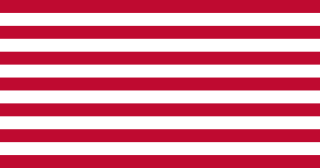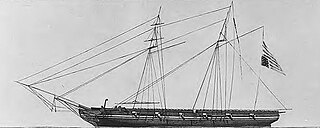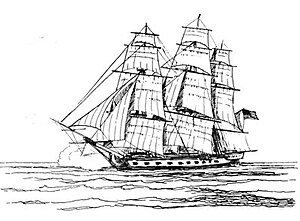
The Quasi-War was an undeclared naval war fought from 1798 to 1800 between the United States and the French First Republic, primarily in the Caribbean and off the East Coast of the United States.
The first USS Virginia was a 28-gun sailing frigate of the Continental Navy, a ship with a short and unfortunate career.

The Continental Navy was the navy of the Thirteen Colonies during the American Revolutionary War. Founded on October 13, 1775, the fleet developed into a relatively substantial force throughout the Revolutionary War, owing partially to the substantial efforts of the Continental Navy's patrons within the Continental Congress. These Congressional Patrons included the likes of John Adams, who served as the Chairman of the Naval Committee until 1776, when Commodore Esek Hopkins received instruction from the Continental Congress to assume command of the force.

Nicholas Biddle was one of the first five captains of the Continental Navy, which was raised by the Continental Congress during the American Revolutionary War. Biddle was born in Philadelphia in 1750. He began sailing at the age of 13 and joined the Royal Navy when he was 20. In 1773, he sailed the Arctic with Constantine Phipps and Horatio Nelson. When the Revolutionary War began in 1775, Biddle joined the Continental Navy and commanded several ships. In 1778 off the coast of Barbados, Biddle confronted HMS Yarmouth, a 64-gun British warship. After a twenty-minute battle, Biddle's ship Randolph suddenly exploded, killing him and most of his men. Four ships of the U.S. Navy have been named in his honor.
John Peck Rathbun (1746–1782) was an officer in the Continental Navy and in the United States Navy. Rathbun was from Rhode Island with family in Boston. Rathbun served in the Continental Navy from its late 1775 beginning as John Paul Jones First Lieutenant.

The first John Adams was originally built in 1799 as a frigate for the United States Navy, converted to a corvette in 1809, and later converted back to a frigate in 1830. Named for American Founding Father and president John Adams, she fought in the Quasi-War, the First and Second Barbary Wars, the War of 1812, the Mexican–American War and the American Civil War.

A South Carolina Navy has been formed twice by the State of South Carolina. The first time was during the American Revolutionary War, in which the state purchased and outfitted armed vessels independent of the Continental Navy. The second time was during the American Civil War, when its navy was also distinct from the Confederate States Navy.

HMS Astraea was a 32-gun fifth rate Active-class frigate of the Royal Navy. Fabian at E. Cowes launched her in 1781, and she saw action in the American War of Independence as well as during the Napoleonic Wars. She is best known for her capture of the larger French frigate Gloire in a battle on 10 April 1795, while under the command of Captain Lord Henry Paulet. She was wrecked on 23 March 1808 off the coast of Anegada in the British Virgin Islands.

Indien, often L'Indien, was a frigate built for the U.S. Commissioners in France – Benjamin Franklin, Silas Deane, and Arthur Lee – to a design by the French naval architect Jacques Boux. She was laid down early in 1777 by a private shipyard in Amsterdam and launched in February 1778. Apparently she was built with the scantlings and lines of a small 74-gun Third Rate ship of the line but was a frigate in construction. In 1780 the Duke of Luxembourg chartered her to the navy of South Carolina and she sailed as South Carolina.
USS Saratoga was a sloop in the Continental Navy. She was the first ship to honor the historic Battle of Saratoga. Having disappeared in 1781, her fate remains a mystery.

HMS Yarmouth was a 64-gun third rate ship of the line of the Royal Navy, designed and built by Joseph Allin the younger at Deptford Dockyard. She was previously ordered to the dimensions specified in the 1741 proposals for modifications to the 1719 Establishment, but the Admiralty had very quickly concluded that these were too small, and as an experiment in 1742 authorised an addition of 6ft to the planned length, and Yarmouth was re-ordered to the enlarged design in June 1742. She was built at Deptford, where the Admiralty felt they could best observe the effectiveness of the added size, and launched on 8 March 1745.
HMS Ariel was a 20-gun Sphinx-class sixth-rate post ship of the Royal Navy. The French captured her in 1779, and she served during the American Revolutionary War for them, and later for the Americans, before reverting to French control. Her French crew scuttled Ariel in 1793 to prevent the British from recapturing her.

The action of 21 July 1781 was a naval skirmish off the harbour of Spanish River, Cape Breton, Nova Scotia, during the War of American Independence. Two light frigates of the French Navy, captained by La Pérouse and Latouche Tréville, engaged a convoy of 18 British ships and their Royal Navy escorts. The French captured two of the British escorts while the remainder of the British convoy escaped.

HMS Camilla was a Royal Navy 20-gun Sphinx-class post ship. Camilla was built in Chatham Dockyard to a design by John Williams and was launched in 1776. She served in the American Revolution, the French Revolutionary Wars, and the Napoleonic Wars, before being sold in 1831.

The West Indies Anti-Piracy Operations were a series of military operations and engagements undertaken by the United States Navy against pirates in and around the Antilles. Between 1814 and 1825, the American West Indies Squadron hunted pirates on both sea and land, primarily around Cuba and Puerto Rico. After the capture of Roberto Cofresi in 1825, acts of piracy became rare, and the operation was considered a success, although limited occurrences went on until slightly after the start of the 20th century.

The Battle of Barbados was fought in March 1778 during the American Revolutionary War. While escorting a fleet of American ships in the West Indies, the frigate USS Randolph was attacked by the British ship-of-the-line HMS Yarmouth. The following action resulted in America's most costly naval defeat, in terms of human lives, until the sinking of USS Arizona in 1941.

HMS Lizard was a 28-gun Coventry-class sixth-rate frigate of the Royal Navy, in service from 1757 to 1828. Named after the Lizard, a peninsula in southern Cornwall, she was a broad-beamed and sturdy vessel designed for lengthy periods at sea. Her crewing complement was 200 and, when fully equipped, she was armed with 24 nine-pounder cannons, supported by four three-pounders and twelve 1⁄2-pounder swivel guns. Despite her sturdy build, she was plagued with maintenance problems and had to be repeatedly removed from service for repair.

HMS Levant was a 28-gun sixth-rate frigate of the Coventry class, which saw Royal Navy service against France in the Seven Years' War, and against France, Spain and the American colonies during the American Revolutionary War. Principally a hunter of privateers, she was also designed to be a match for small French frigates, but with a broader hull and sturdier build at the expense of some speed and manoeuvrability. Launched in 1758, Levant was assigned to the Royal Navy's Jamaica station from 1759 and proved her worth by defeating nine French vessels during her first three years at sea. She was also part of the British expedition against Martinique in 1762 but played no role in the landings or subsequent defeat of French forces at Fort Royal.

HMS Milford was a 28-gun Coventry-class sixth-rate frigate of the Royal Navy. She was built at Milford by Richard Chitty and launched in 1759. She was sold for breaking at Woolwich on 17 May 1785.

HMS Roebuck was a fifth-rate ship of the Royal Navy which served in the American and French Revolutionary Wars. Designed in 1769 by Sir Thomas Slade to operate in the shallower waters of North America, she joined Lord Howe's squadron towards the end of 1775 and took part in operations against New York the following year. She engaged the American gun batteries at Red Hook during the Battle of Long Island in August 1776, and forced a passage up the Hudson River in October. On 25 August 1777, Roebuck escorted troopships to Turkey Point, Maryland, where an army was landed for an assault on Philadelphia. She was again called upon to accompany troopships in December 1779, this time for an attack on Charleston. When the ships-of-the-line, which were too large to enter the harbour, were sent back to New York, Admiral Marriot Arbuthnot made Roebuck his flagship. She was, therefore, at the front of the attack, leading the British squadron across the shoal to engage Fort Moultrie and the American ships beyond.














